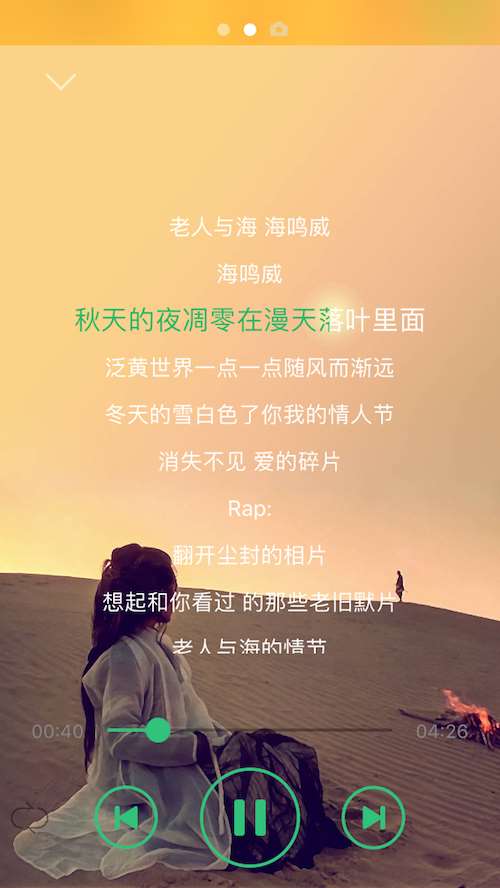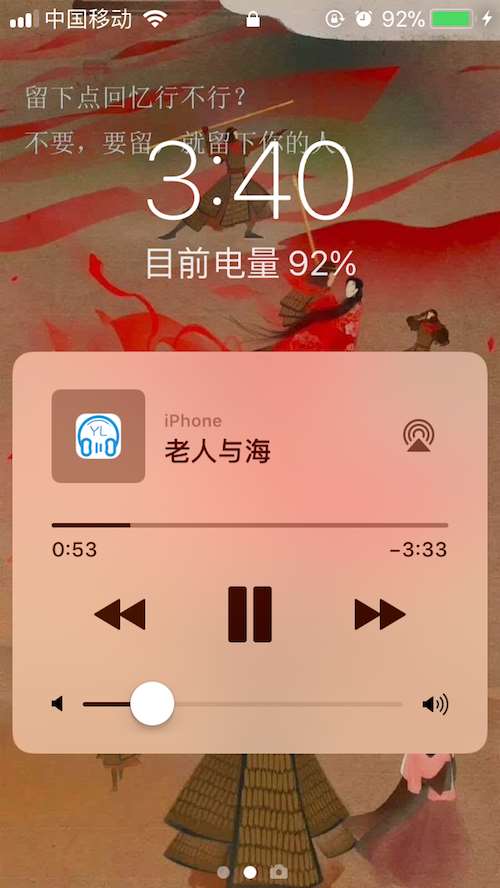前提準(zhǔn)備
為了能夠有明確的思路來(lái)做這個(gè)demo,我下載了QQ音樂(lè)和網(wǎng)易云音樂(lè),然后分別對(duì)比,最終選擇了QQ音樂(lè)來(lái)參照,先是獲取了其中的所有資源文件(如果有不知道怎么提取資源文件的,可以參考iOS提取APP中的圖片資源),在這之后就是研究使用技術(shù),這里我選擇了FreeStreamer,雖然系統(tǒng)也有,但是該框架可能更好用點(diǎn)。
實(shí)現(xiàn)部分
在這之前,先來(lái)看看大概效果圖吧



再看完效果圖之后,我們就來(lái)看看這其中涉及到的幾個(gè)難點(diǎn)吧(在我看開~)
1、先讓播放器跑起來(lái)
這里我使用的是pods來(lái)管理三方庫(kù),代碼如下
platform:ios,'8.0'target "GLMusicBox" dopod 'FreeStreamer', '~> 3.7.3'pod 'SDWebImage', '~> 4.0.0'pod 'MJRefresh', '~> 3.1.11'pod 'Masonry', '~> 1.0.2'pod 'Reachability', '~> 3.2'pod 'AFNetworking', '~> 3.0'pod 'IQKeyboardManager', '~> 3.3.2'end
針對(duì)FreeStreamer我簡(jiǎn)單進(jìn)行了封裝下
#import "FSAudioStream.h"@class GLMusicLRCModel;typedef NS_ENUM(NSInteger,GLLoopState){ GLSingleLoop = 0,//單曲循環(huán) GLForeverLoop,//重復(fù)循環(huán) GLRandomLoop,//隨機(jī)播放 GLOnceLoop//列表一次順序播放};@protocol GLMusicPlayerDelegate/** * 實(shí)時(shí)更新 * **/- (void)updateProgressWithCurrentPosition:(FSStreamPosition)currentPosition endPosition:(FSStreamPosition)endPosition;- (void)updateMusicLrc;@end@interface GLMusicPlayer : FSAudioStream/** * 播放列表 * **/@property (nonatomic,strong) NSMutableArray *musicListArray;/** 當(dāng)前播放歌曲的歌詞 */@property (nonatomic,strong) NSMutableArray *musicLRCArray;/** * 當(dāng)前播放 * **/@property (nonatomic,assign,readonly) NSUInteger currentIndex;/** * 當(dāng)前播放的音樂(lè)的標(biāo)題 * **/@property (nonatomic,strong) NSString *currentTitle;/** 是否是暫停狀態(tài) */@property (nonatomic,assign) BOOL isPause;@property (nonatomic,weak) idglPlayerDelegate;//默認(rèn) 重復(fù)循環(huán) GLForeverLoop@property (nonatomic,assign) GLLoopState loopState;/** * 單例播放器 * **/+ (instancetype)defaultPlayer;/** 播放隊(duì)列中的指定的文件 @param index 序號(hào) */- (void)playMusicAtIndex:(NSUInteger)index;/** 播放前一首 */- (void)playFont;/** 播放下一首 */- (void)playNext;@end這里繼承了FSAudioStream,并且采用了單例模式
+ (instancetype)defaultPlayer{ static GLMusicPlayer *player = nil; static dispatch_once_t onceToken; dispatch_once(&onceToken, ^{ FSStreamConfiguration *config = [[FSStreamConfiguration alloc] init]; config.httpConnectionBufferSize *=2; config.enableTimeAndPitchConversion = YES; player = [[super alloc] initWithConfiguration:config]; player.delegate = (id)self; player.onFailure = ^(FSAudioStreamError error, NSString *errorDescription) { //播放錯(cuò)誤 //有待解決 }; player.onCompletion = ^{ //播放完成 NSLog(@" 打印信息: 播放完成1"); }; player.onStateChange = ^(FSAudioStreamState state) { switch (state) { case kFsAudioStreamPlaying: { NSLog(@" 打印信息 playing....."); player.isPause = NO; [GLMiniMusicView shareInstance].palyButton.selected = YES; } break; case kFsAudioStreamStopped: { NSLog(@" 打印信息 stop.....%@",player.url.absoluteString); } break; case kFsAudioStreamPaused: { //pause player.isPause = YES; [GLMiniMusicView shareInstance].palyButton.selected = NO; NSLog(@" 打印信息: pause"); } break; case kFsAudioStreamPlaybackCompleted: { NSLog(@" 打印信息: 播放完成2"); [player playMusicForState]; } break; default: break; } }; //設(shè)置音量 [player setVolume:0.5]; //設(shè)置播放速率 [player setPlayRate:1]; player.loopState = GLForeverLoop; }); return player;}然后實(shí)現(xiàn)了播放方法
- (void)playFromURL:(NSURL *)url{ //根據(jù)地址 在本地找歌詞 NSMutableDictionary *dic = [NSMutableDictionary dictionaryWithContentsOfFile:[[NSBundle mainBundle] pathForResource:@"musiclist" ofType:@"plist"]]; for (NSString *playStringKey in dic.allKeys) { if ([[dic valueForKey:playStringKey] isEqualToString:url.absoluteString]) { self.currentTitle = playStringKey; break; } } [self stop]; if (![url.absoluteString isEqualToString:self.url.absoluteString]) { [super playFromURL:url]; }else{ [self play]; } NSLog(@" 當(dāng)前播放歌曲:%@",self.currentTitle); [GLMiniMusicView shareInstance].titleLable.text = self.currentTitle; //獲取歌詞 NSString *lrcFile = [NSString stringWithFormat:@"%@.lrc",self.currentTitle]; self.musicLRCArray = [NSMutableArray arrayWithArray:[GLMusicLRCModel musicLRCModelsWithLRCFileName:lrcFile]]; if (![self.musicListArray containsObject:url]) { [self.musicListArray addObject:url]; } //更新主界面歌詞UI if (self.glPlayerDelegate && [self.glPlayerDelegate respondsToSelector:@selector(updateMusicLrc)]) { [self.glPlayerDelegate updateMusicLrc]; } _currentIndex = [self.musicListArray indexOfObject:url]; if (!_progressTimer) { _progressTimer = [CADisplayLink displayLinkWithTarget:self selector:@selector(updateProgress)]; [_progressTimer addToRunLoop:[NSRunLoop mainRunLoop] forMode:NSRunLoopCommonModes]; }}在上面的代碼中,有許多邏輯是后面加的,比如更新UI界面,獲取歌詞等處理,如果要實(shí)現(xiàn)簡(jiǎn)單的播放,則可以不用重寫該方法,直接通過(guò)playFromURL就可以實(shí)現(xiàn)我們的播放功能。
2、更新UI
這里的UI暫不包括歌詞的更新,而只是進(jìn)度條的更新,要更新進(jìn)度條,比不可少的是定時(shí)器,這里我沒(méi)有選擇NSTimer,而是選擇了CADisplayLink,至于為什么,我想大家應(yīng)該都比較了解,可以這么來(lái)對(duì)比,下面引用一段其他博客的對(duì)比:
iOS設(shè)備的屏幕刷新頻率是固定的,CADisplayLink在正常情況下會(huì)在每次刷新結(jié)束都被調(diào)用,精確度相當(dāng)高。
NSTimer的精確度就顯得低了點(diǎn),比如NSTimer的觸發(fā)時(shí)間到的時(shí)候,runloop如果在阻塞狀態(tài),觸發(fā)時(shí)間就會(huì)推遲到下一個(gè)runloop周期。并且 NSTimer新增了tolerance屬性,讓用戶可以設(shè)置可以容忍的觸發(fā)的時(shí)間的延遲范圍。
CADisplayLink使用場(chǎng)合相對(duì)專一,適合做UI的不停重繪,比如自定義動(dòng)畫引擎或者視頻播放的渲染。NSTimer的使用范圍要廣泛的多,各種需要單次或者循環(huán)定時(shí)處理的任務(wù)都可以使用。在UI相關(guān)的動(dòng)畫或者顯示內(nèi)容使用 CADisplayLink比起用NSTimer的好處就是我們不需要在格外關(guān)心屏幕的刷新頻率了,因?yàn)樗旧砭褪歉聊凰⑿峦降?/p>
使用方法
if (!_progressTimer) { _progressTimer = [CADisplayLink displayLinkWithTarget:self selector:@selector(updateProgress)]; [_progressTimer addToRunLoop:[NSRunLoop mainRunLoop] forMode:NSRunLoopCommonModes]; }更新進(jìn)度
- (void)updateProgress{ if (self.glPlayerDelegate && [self.glPlayerDelegate respondsToSelector:@selector(updateProgressWithCurrentPosition:endPosition:)]) { [self.glPlayerDelegate updateProgressWithCurrentPosition:self.currentTimePlayed endPosition:self.duration]; } [self showLockScreenCurrentTime:(self.currentTimePlayed.second + self.currentTimePlayed.minute * 60) totalTime:(self.duration.second + self.duration.minute * 60)];}在這里有兩個(gè)屬性:currentTimePlayed和duration,分別保存著當(dāng)前播放時(shí)間和總時(shí)間,是如下的結(jié)構(gòu)體
typedef struct { unsigned minute; unsigned second; /** * Playback time in seconds. */ float playbackTimeInSeconds; /** * Position within the stream, where 0 is the beginning * and 1.0 is the end. */ float position;} FSStreamPosition;我們?cè)诟耈I的時(shí)候,主要可以根據(jù)其中的minute和second來(lái),如果播放了90s,那么minute就為1,而second為30,所以我們?cè)谟?jì)算的時(shí)候,應(yīng)該是這樣的(self.currentTimePlayed.second + self.currentTimePlayed.minute * 60)
當(dāng)然在更新進(jìn)度條的時(shí)候,我們也可以通過(guò)position直接來(lái)給slider進(jìn)行賦值,這表示當(dāng)前播放的比例
#pragma mark == GLMusicPlayerDelegate- (void)updateProgressWithCurrentPosition:(FSStreamPosition)currentPosition endPosition:(FSStreamPosition)endPosition{ //更新進(jìn)度條 self.playerControlView.slider.value = currentPosition.position; self.playerControlView.leftTimeLable.text = [NSString translationWithMinutes:currentPosition.minute seconds:currentPosition.second]; self.playerControlView.rightTimeLable.text = [NSString translationWithMinutes:endPosition.minute seconds:endPosition.second]; //更新歌詞 [self updateMusicLrcForRowWithCurrentTime:currentPosition.position *(endPosition.minute *60 + endPosition.second)]; self.playerControlView.palyMusicButton.selected = [GLMusicPlayer defaultPlayer].isPause;}本項(xiàng)目中,slider控件沒(méi)有用系統(tǒng)的,而是簡(jiǎn)單的寫了一個(gè),大概如下
@interface GLSlider : UIControl//進(jìn)度條顏色@property (nonatomic,strong) UIColor *progressColor;//緩存條顏色@property (nonatomic,strong) UIColor *progressCacheColor;//滑塊顏色@property (nonatomic,strong) UIColor *thumbColor;//設(shè)置進(jìn)度值 0-1@property (nonatomic,assign) CGFloat value;//設(shè)置緩存進(jìn)度值 0-1@property (nonatomic,assign) CGFloat cacheValue;@endstatic CGFloat const kProgressHeight = 2;static CGFloat const kProgressLeftPadding = 2;static CGFloat const kThumbHeight = 16;@interface GLSlider()//滑塊 默認(rèn)@property (nonatomic,strong) CALayer *thumbLayer;//進(jìn)度條@property (nonatomic,strong) CALayer *progressLayer;//緩存進(jìn)度條@property (nonatomic,strong) CALayer *progressCacheLayer;@property (nonatomic,assign) BOOL isTouch;@end@implementation GLSlider- (id)initWithFrame:(CGRect)frame{ self = [super initWithFrame:frame]; if (self) { [self addSubLayers]; } return self;}....這里是添加了緩存進(jìn)度條的,但是由于時(shí)間關(guān)系,代碼中還未實(shí)時(shí)更新緩存進(jìn)度
3、更新歌詞界面
說(shuō)到歌詞界面,我們看到QQ音樂(lè)的效果是這樣的,逐行逐字進(jìn)行更新,注意不是逐行更新。考慮到逐字進(jìn)行更新,那么我們必須要對(duì)lable進(jìn)行干點(diǎn)什么,這里對(duì)其進(jìn)行了繼承,并添加了些方法
@interface GLMusicLrcLable : UILabel//進(jìn)度@property (nonatomic,assign) CGFloat progress;@end
#import "GLMusicLrcLable.h"@implementation GLMusicLrcLable- (void)setProgress:(CGFloat)progress{ _progress = progress; //重繪 [self setNeedsDisplay];}- (void)drawRect:(CGRect)rect{ [super drawRect:rect]; CGRect fillRect = CGRectMake(0, 0, self.bounds.size.width * _progress, self.bounds.size.height); [UICOLOR_FROM_RGB(45, 185, 105) set]; UIRectFillUsingBlendMode(fillRect, kCGBlendModeSourceIn);}@end注意UIRectFillUsingBlendMode該方法能夠?qū)崿F(xiàn)逐字進(jìn)行漸變的效果
逐字的問(wèn)題解決了,那么就剩下逐行問(wèn)題了,逐行的問(wèn)題應(yīng)該不難,是的。我們只需要在指定的時(shí)間內(nèi)將其滾動(dòng)就行,如下
但是這中要注意一個(gè)問(wèn)題,那就是必須做到,在下一行進(jìn)行展示的時(shí)候,取消上一行的效果,如下
//設(shè)置當(dāng)前行的狀態(tài) [currentCell reloadCellForSelect:YES]; //取消上一行的選中狀態(tài) [previousCell reloadCellForSelect:NO];
- (void)reloadCellForSelect:(BOOL)select{ if (select) { _lrcLable.font = [UIFont systemFontOfSize:17]; }else{ _lrcLable.font = [UIFont systemFontOfSize:14]; _lrcLable.progress = 0; }}其中_lrcLable.progress = 0;必須要,否則我們的文字顏色不會(huì)改變
在大問(wèn)題已經(jīng)解決的情況下,我們就需要關(guān)心另一個(gè)重要的問(wèn)題了,那就是歌詞。這里先介紹一個(gè)網(wǎng)站,可以獲取歌曲名和歌詞的
(找了好久....) 歌曲歌詞獲取 ,不過(guò)好多好聽的歌曲居然播放不了,你懂得,大天朝版權(quán)問(wèn)題....找一首歌,播放就能看到看到歌詞了。關(guān)于歌詞,有許多格式,這里我用的是lrc格式,應(yīng)該還算比較主流,格式大概如下
[ti:老人與海][ar:海鳴威 ][al:單曲][by:www.5nd.com From 那時(shí)花開][00:04.08]老人與海 海鳴威[00:08.78]海鳴威[00:37.06]秋天的夜凋零在漫天落葉里面[00:42.43]泛黃世界一點(diǎn)一點(diǎn)隨風(fēng)而漸遠(yuǎn)[00:47.58]冬天的雪白色了你我的情人節(jié)[00:53.24]消失不見 愛(ài)的碎片[00:57.87]Rap:[00:59.32]翻開塵封的相片[01:00.87]想起和你看過(guò) 的那些老舊默片[01:02.50]老人與海的情節(jié)[01:04.23]畫面中你卻依稀 在浮現(xiàn)
在有了格式后,我們就需要一個(gè)模型,來(lái)分離歌曲信息了,下面是我建的模型
#import @interface GLMusicLRCModel : NSObject//該段歌詞對(duì)應(yīng)的時(shí)間@property (nonatomic,assign) NSTimeInterval time;//歌詞@property (nonatomic,strong) NSString *title;/** * 將特點(diǎn)的歌詞格式進(jìn)行轉(zhuǎn)換 * **/+ (id)musicLRCWithString:(NSString *)string;/** * 根據(jù)歌詞的路徑返回歌詞模型數(shù)組 * **/+ (NSArray *)musicLRCModelsWithLRCFileName:(NSString *)name;@end
#import "GLMusicLRCModel.h"@implementation GLMusicLRCModel+(id)musicLRCWithString:(NSString *)string{ GLMusicLRCModel *model = [[GLMusicLRCModel alloc] init]; NSArray *lrcLines =[string componentsSeparatedByString:@"]"]; if (lrcLines.count == 2) { model.title = lrcLines[1]; NSString *timeString = lrcLines[0]; timeString = [timeString stringByReplacingOccurrencesOfString:@"[" withString:@""]; timeString = [timeString stringByReplacingOccurrencesOfString:@"]" withString:@""]; NSArray *times = [timeString componentsSeparatedByString:@":"]; if (times.count == 2) { NSTimeInterval time = [times[0] integerValue]*60 + [times[1] floatValue]; model.time = time; } }else if(lrcLines.count == 1){ } return model;}+(NSArray *)musicLRCModelsWithLRCFileName:(NSString *)name{ NSString *lrcPath = [[NSBundle mainBundle] pathForResource:name ofType:nil]; NSString *lrcString = [NSString stringWithContentsOfFile:lrcPath encoding:NSUTF8StringEncoding error:nil]; NSArray *lrcLines = [lrcString componentsSeparatedByString:@"/n"]; NSMutableArray *lrcModels = [NSMutableArray array]; for (NSString *lrcLineString in lrcLines) { if ([lrcLineString hasPrefix:@"[ti"] || [lrcLineString hasPrefix:@"[ar"] || [lrcLineString hasPrefix:@"[al"] || ![lrcLineString hasPrefix:@"["]) { continue; } GLMusicLRCModel *lrcModel = [GLMusicLRCModel musicLRCWithString:lrcLineString]; [lrcModels addObject:lrcModel]; } return lrcModels;}@end在歌詞模型準(zhǔn)備好之后,我們要展示歌詞,這里我選擇的是tableview,通過(guò)每一個(gè)cell來(lái)加載不同的歌詞,然后通過(guò)歌詞的時(shí)間信息來(lái)更新和滾動(dòng)
#pragma mark == UITableViewDataSource- (NSInteger)tableView:(UITableView *)tableView numberOfRowsInSection:(NSInteger)section{ return [GLMusicPlayer defaultPlayer].musicLRCArray.count;}- (UITableViewCell *)tableView:(UITableView *)tableView cellForRowAtIndexPath:(NSIndexPath *)indexPath{ MusicLRCTableViewCell *cell = [tableView dequeueReusableCellWithIdentifier:@"musicLrc" forIndexPath:indexPath]; cell.selectionStyle = UITableViewCellSelectionStyleNone; cell.backgroundColor = [UIColor clearColor]; cell.contentView.backgroundColor = [UIColor clearColor]; cell.lrcModel = [GLMusicPlayer defaultPlayer].musicLRCArray[indexPath.row]; if (indexPath.row == self.currentLcrIndex) { [cell reloadCellForSelect:YES]; }else{ [cell reloadCellForSelect:NO]; } return cell;}這里面唯一比較麻煩的可能就是更新歌詞了,在上面的定時(shí)器中,我們也通過(guò)代理來(lái)更新了進(jìn)度條,所以我也將更新歌詞的部分放在了代理中,這樣可以達(dá)到實(shí)時(shí)更新的目的,下面看看方法
//逐行更新歌詞- (void)updateMusicLrcForRowWithCurrentTime:(NSTimeInterval)currentTime{ for (int i = 0; i < [GLMusicPlayer defaultPlayer].musicLRCArray.count; i ++) { GLMusicLRCModel *model = [GLMusicPlayer defaultPlayer].musicLRCArray[i]; NSInteger next = i + 1; GLMusicLRCModel *nextLrcModel = nil; if (next < [GLMusicPlayer defaultPlayer].musicLRCArray.count) { nextLrcModel = [GLMusicPlayer defaultPlayer].musicLRCArray[next]; } if (self.currentLcrIndex != i && currentTime >= model.time) { BOOL show = NO; if (nextLrcModel) { if (currentTime < nextLrcModel.time) { show = YES; } }else{ show = YES; } if (show) { NSIndexPath *currentIndexPath = [NSIndexPath indexPathForRow:i inSection:0]; NSIndexPath *previousIndexPath = [NSIndexPath indexPathForRow:self.currentLcrIndex inSection:0]; self.currentLcrIndex = i; MusicLRCTableViewCell *currentCell = [self.lrcTableView cellForRowAtIndexPath:currentIndexPath]; MusicLRCTableViewCell *previousCell = [self.lrcTableView cellForRowAtIndexPath:previousIndexPath]; //設(shè)置當(dāng)前行的狀態(tài) [currentCell reloadCellForSelect:YES]; //取消上一行的選中狀態(tài) [previousCell reloadCellForSelect:NO]; if (!self.isDrag) { [self.lrcTableView scrollToRowAtIndexPath:currentIndexPath atScrollPosition:UITableViewScrollPositionMiddle animated:YES]; } } } if (self.currentLcrIndex == i) { MusicLRCTableViewCell *cell = [self.lrcTableView cellForRowAtIndexPath:[NSIndexPath indexPathForRow:i inSection:0]]; CGFloat totalTime = 0; if (nextLrcModel) { totalTime = nextLrcModel.time - model.time; }else{ totalTime = [GLMusicPlayer defaultPlayer].duration.minute * 60 + [GLMusicPlayer defaultPlayer].duration.second - model.time; } CGFloat progressTime = currentTime - model.time; cell.lrcLable.progress = progressTime / totalTime; } }}到此為止,我們一個(gè)簡(jiǎn)單的播放器就差不多實(shí)現(xiàn)了,但是這...并沒(méi)有完,相比QQ音樂(lè)而言,它還差一個(gè)播放順序切換的功能和鎖屏播放功能
4、切換播放順序
這個(gè)比較簡(jiǎn)單,只是需要注意在切換的時(shí)候,注意數(shù)組的越界和不同模式的處理
這里,我定義了如下幾種模式
typedef NS_ENUM(NSInteger,GLLoopState){ GLSingleLoop = 0,//單曲循環(huán) GLForeverLoop,//重復(fù)循環(huán) GLRandomLoop,//隨機(jī)播放 GLOnceLoop//列表一次順序播放};切換代碼
//不同狀態(tài)下 播放歌曲- (void)playMusicForState{ switch (self.loopState) { case GLSingleLoop: { [self playMusicAtIndex:self.currentIndex]; } break; case GLForeverLoop: { if (self.currentIndex == self.musicListArray.count-1) { [self playMusicAtIndex:0]; }else{ [self playMusicAtIndex:self.currentIndex + 1]; } } break; case GLRandomLoop: { //取隨機(jī)值 int index = arc4random() % self.musicListArray.count; [self playMusicAtIndex:index]; } break; case GLOnceLoop: { if (self.currentIndex == self.musicListArray.count-1) { [self stop]; }else{ [self playMusicAtIndex:self.currentIndex + 1]; } } break; default: break; }}5、鎖屏播放
就如上圖2中那樣,由于在iOS 11中好像不能支持背景圖片和歌詞展示,可能是為了界面更加簡(jiǎn)潔吧,所以我這里也就沒(méi)有加該功功能,只是簡(jiǎn)答的有個(gè)播放界面和幾個(gè)控制按鈕
首先需要在工程中這樣設(shè)置,保證在后臺(tái)播放

然后就是在appdelegate中添加如下代碼
AVAudioSession *session = [AVAudioSession sharedInstance];// [session setActive:YES error:nil]; [session setActive:YES withOptions:AVAudioSessionSetActiveOptionNotifyOthersOnDeactivation error:nil]; [session setCategory:AVAudioSessionCategoryPlayback error:nil]; [[UIApplication sharedApplication] beginReceivingRemoteControlEvents];
并且添加控制事件
#pragma mark == event response-(void)remoteControlReceivedWithEvent:(UIEvent *)event{ NSLog(@"%ld",event.subtype); if (event.type == UIEventTypeRemoteControl) { switch (event.subtype) { case UIEventSubtypeRemoteControlPlay: { //點(diǎn)擊播放按鈕或者耳機(jī)線控中間那個(gè)按鈕 [[GLMusicPlayer defaultPlayer] pause]; } break; case UIEventSubtypeRemoteControlPause: { //點(diǎn)擊暫停按鈕 [[GLMusicPlayer defaultPlayer] pause]; } break; case UIEventSubtypeRemoteControlStop : { //點(diǎn)擊停止按鈕 [[GLMusicPlayer defaultPlayer] stop]; } break; case UIEventSubtypeRemoteControlTogglePlayPause: { //點(diǎn)擊播放與暫停開關(guān)按鈕(iphone抽屜中使用這個(gè)) [[GLMusicPlayer defaultPlayer] pause]; } break; case UIEventSubtypeRemoteControlNextTrack: { //點(diǎn)擊下一曲按鈕或者耳機(jī)中間按鈕兩下 [[GLMusicPlayer defaultPlayer] playNext]; } break; case UIEventSubtypeRemoteControlPreviousTrack: { //點(diǎn)擊上一曲按鈕或者耳機(jī)中間按鈕三下 [[GLMusicPlayer defaultPlayer] playFont]; } break; case UIEventSubtypeRemoteControlBeginSeekingBackward: { //快退開始 點(diǎn)擊耳機(jī)中間按鈕三下不放開 } break; case UIEventSubtypeRemoteControlEndSeekingBackward: { //快退結(jié)束 耳機(jī)快退控制松開后 } break; case UIEventSubtypeRemoteControlBeginSeekingForward: { //開始快進(jìn) 耳機(jī)中間按鈕兩下不放開 } break; case UIEventSubtypeRemoteControlEndSeekingForward: { //快進(jìn)結(jié)束 耳機(jī)快進(jìn)操作松開后 } break; default: break; } }}beginReceivingRemoteControlEvents為允許傳遞遠(yuǎn)程控制事件,remoteControlReceivedWithEvent為接收一個(gè)遠(yuǎn)程控制事件,關(guān)于控制事件的類型,在代碼中,已經(jīng)注釋過(guò),這里就不再說(shuō)了。
控制事件搞定了,剩下的就是界面的展示了,主要是歌曲信息的展示,通過(guò)如下的代碼就能實(shí)現(xiàn)
NSMutableDictionary *musicInfoDict = [[NSMutableDictionary alloc] init]; //設(shè)置歌曲題目 [musicInfoDict setObject:self.currentTitle forKey:MPMediaItemPropertyTitle]; //設(shè)置歌手名 [musicInfoDict setObject:@"" forKey:MPMediaItemPropertyArtist]; //設(shè)置專輯名 [musicInfoDict setObject:@"" forKey:MPMediaItemPropertyAlbumTitle]; //設(shè)置歌曲時(shí)長(zhǎng) [musicInfoDict setObject:[NSNumber numberWithFloat:totalTime] forKey:MPMediaItemPropertyPlaybackDuration]; //設(shè)置已經(jīng)播放時(shí)長(zhǎng) [musicInfoDict setObject:[NSNumber numberWithFloat:currentTime] forKey:MPNowPlayingInfoPropertyElapsedPlaybackTime]; [[MPNowPlayingInfoCenter defaultCenter] setNowPlayingInfo:musicInfoDict];
關(guān)于歌曲信息的設(shè)置,可以不按照我這樣,定時(shí)器中時(shí)刻進(jìn)行刷新,只需要在播放、暫停、快進(jìn)快退這些時(shí)間有變化的地方傳入當(dāng)前歌曲的關(guān)鍵信息就可以,系統(tǒng)會(huì)自動(dòng)去根據(jù)播放情況去更新鎖屏界面上的進(jìn)度條,而不需要我們時(shí)刻傳入當(dāng)前播放時(shí)間。這里我為了偷懶,就加在里面了。為了防止頻繁操作,我采取了個(gè)方法,在其他地方看到的,就是監(jiān)聽鎖屏情況
//監(jiān)聽鎖屏狀態(tài) lock=1則為鎖屏狀態(tài) uint64_t locked; __block int token = 0; notify_register_dispatch("com.apple.springboard.lockstate",&token,dispatch_get_main_queue(),^(int t){ }); notify_get_state(token, &locked); //監(jiān)聽屏幕點(diǎn)亮狀態(tài) screenLight = 1則為變暗關(guān)閉狀態(tài) uint64_t screenLight; __block int lightToken = 0; notify_register_dispatch("com.apple.springboard.hasBlankedScreen",&lightToken,dispatch_get_main_queue(),^(int t){ }); notify_get_state(lightToken, &screenLight);通過(guò)該情況來(lái)設(shè)置。
在上面鎖屏播放的過(guò)程中,出現(xiàn)一個(gè)問(wèn)題,就是當(dāng)我切換歌曲的時(shí)候,不管是在鎖屏情況下,還是在app內(nèi)
通過(guò)各種查找,大概找到問(wèn)題,首先在appdelegate中將[session setActive:YES error:nil]改成了[session setActive:YES withOptions:AVAudioSessionSetActiveOptionNotifyOthersOnDeactivation error:nil],然后再播放的地方加了一個(gè)[self stop],先停止播放
- (void)playFromURL:(NSURL *)url{ //根據(jù)地址 在本地找歌詞 NSMutableDictionary *dic = [NSMutableDictionary dictionaryWithContentsOfFile:[[NSBundle mainBundle] pathForResource:@"musiclist" ofType:@"plist"]]; for (NSString *playStringKey in dic.allKeys) { if ([[dic valueForKey:playStringKey] isEqualToString:url.absoluteString]) { self.currentTitle = playStringKey; break; } } [self stop]; if (![url.absoluteString isEqualToString:self.url.absoluteString]) { [super playFromURL:url]; }else{ [self play]; }到此為止,一個(gè)簡(jiǎn)單的播放器就差不多了,由于時(shí)間關(guān)系,可能還有些bug,希望大家能多多提出來(lái),我好進(jìn)行修正。下面還是附上 demo ,后續(xù)我還將加一個(gè)功能,因?yàn)檫@兩天公司有個(gè)很老的項(xiàng)目,有個(gè)下載問(wèn)題,有點(diǎn)蛋疼,所以準(zhǔn)備些一個(gè)隊(duì)列下載,然后順便加到播放器上。
說(shuō)說(shuō)遇到的坑
第一個(gè)就是我們項(xiàng)目中也有用到科大訊飛的語(yǔ)音.和錄音的功能這些東西都需要對(duì)AVAudioSession進(jìn)行操作.在切換使用AVAudioSession的時(shí)候就會(huì)報(bào)[AVAudioSession setActive:withOptions:error:]: Deactivating an audio session that has running I/O. All I/O should be stopped or paused prior to deactivating the audio session. 這樣的錯(cuò)誤,這個(gè)錯(cuò)會(huì)導(dǎo)致音頻在播放但是沒(méi)有聲音. 我的解決辦法是搜索框架中所有的setActive:NO,把NO改成YES,這個(gè)問(wèn)題就完美的解決了.
第二個(gè)坑就是當(dāng)剛開始緩存但是沒(méi)有出聲音的時(shí)候這個(gè)時(shí)候調(diào)暫停的方法是沒(méi)用的,即使調(diào)用了暫停的方法.但是音頻還是會(huì)播放.我剛開始的解決辦法是在監(jiān)聽FSAudioStreamState的kFsAudioStreamPlaying狀態(tài).在playFromURL:的時(shí)候設(shè)置了一個(gè)屬性Buffering置為YES,在調(diào)用kFsAudioStreamPlaying的置為NO,這樣在暫停方法里這樣寫
- (void)suspentFM { if (self.isSuspendFM==YES) return; if (self.Buffering ==YES) { [_audioStream stop]; }else { [_audioStream pause]; } self.isSuspendFM = YES; _suspentBtn.hidden = NO; } 就解決了這個(gè)問(wèn)題.但是解決的并不完美.kFsAudioStreamPlaying這個(gè)狀態(tài)會(huì)調(diào)用很多次.這樣在少數(shù)情況下還是會(huì)有問(wèn)題,具體情況已經(jīng)忘了.于是乎我就放出了終極大招在定時(shí)器里監(jiān)聽進(jìn)度
if ( progressView.progress<0.007) { self.Buffering = YES; }else { self.Buffering = NO; }到這里才完美的解決這個(gè)問(wèn)題
在接下來(lái)說(shuō)使用小技巧吧.就是緩存的進(jìn)度和播放的進(jìn)度
FSStreamPosition cur = self.audioStream.currentTimePlayed; self.playbackTime =cur.playbackTimeInSeconds/1; self.ProgressView.progress = cur.position;//播放進(jìn)度 self.progress = cur.position; float prebuffer = (float)self.audioStream.prebufferedByteCount; float contentlength = (float)self.audioStream.contentLength; if (contentlength>0) { self.ProgressView.cacheProgress = prebuffer /contentlength;//緩存進(jìn)度 } 以上就是本文的全部?jī)?nèi)容,希望對(duì)大家的學(xué)習(xí)有所幫助,也希望大家多多支持武林網(wǎng)。
新聞熱點(diǎn)
疑難解答
圖片精選